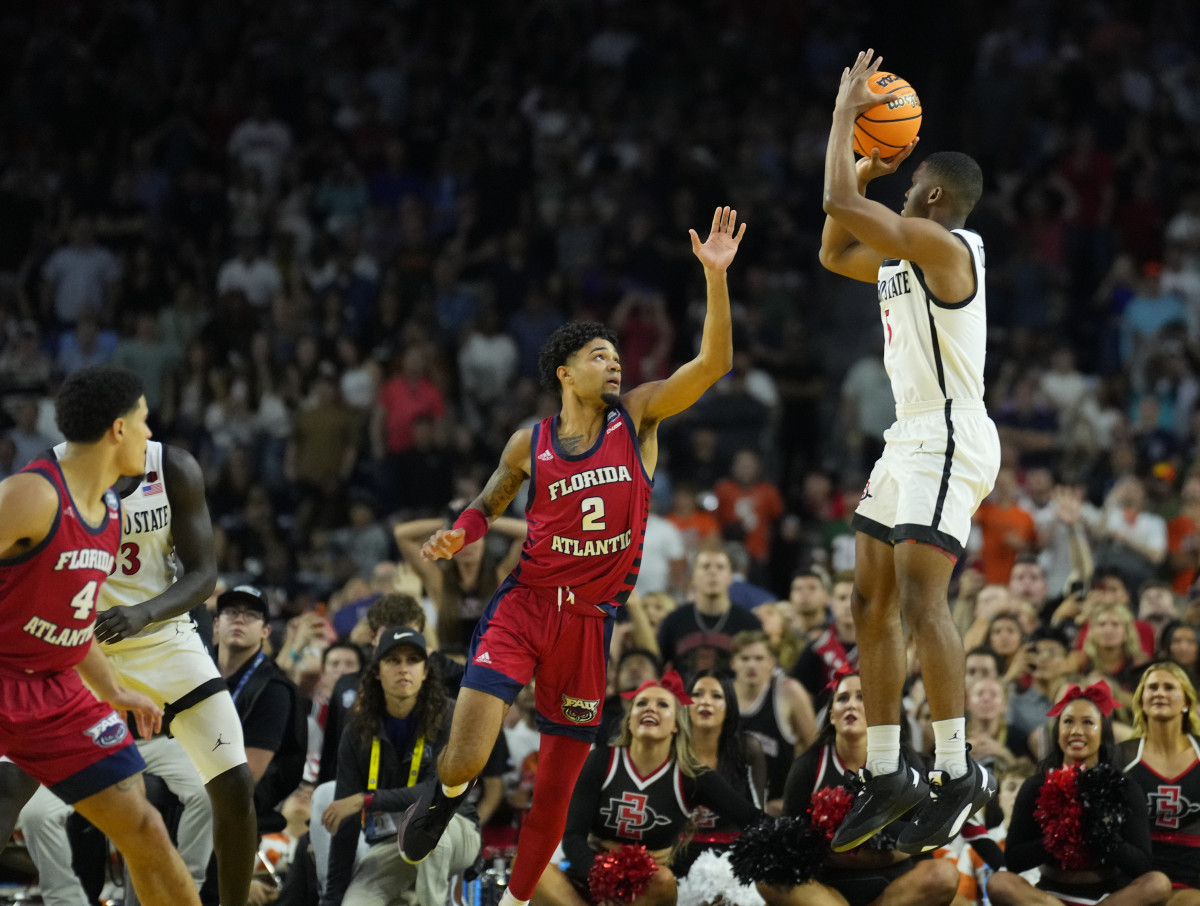SDSU's Win Gave the Men’s Final Four A First-of-Its-Kind Buzzer Beater

Lamont Butler didn’t just make San Diego State history Saturday night. He might well have made NCAA Tournament history.
Butler’s game-winning, 18-foot jump shot against Florida Atlantic appears to be the first of its kind in a Final Four game. It was a true buzzer beater—one that passed through the net during or after the final horn—and it carried with it win-or-lose stakes. If the shot goes in, the Aztecs survive and advance; if the shot misses, FAU wins and San Diego State’s season is over.
That combination of factors is surprisingly non-existent in the history of March Madness, according to sports-reference.com. Butler’s shot appears to be the sixth true buzzer beater in men’s Final Four history, but the first of its kind.
All five other cases occurred in tie games: Jalen Suggs’s half-court shot for Gonzaga in 2021; Kris Jenkins’s long three for Villanova in ’16; Lorenzo Charles’s airball dunk for North Carolina State in 1983; Jerome Whitehead’s semifinal layup for Marquette in ’77; Vic Rouse’s title-game putback for Loyola Chicago in ’63. If any of those shots missed, overtime would have followed.
Other win-or-lose shots came with some time on the clock, most famously Keith Smart’s jumper for Indiana to win the title in 1987. There were some clutch free throws as well: Virginia’s Kyle Guy in 2019 and Michigan’s Rumeal Robinson in ’89.
The only thing that (for now) keeps Butler’s shot from being arguably the most dramatic buzzer beater in men’s Final Four history is that it came in a semifinal, not the championship game.
“If it was to win the title, it might be the greatest ever,” San Diego State coach Brian Dutcher said Sunday. “What an incredible shot. But at the end of the day people are going to talk about who won the national championship. People in San Diego will always remember Lamont’s shot. But if we win the title, then they’re really going to remember that shot. So it all depends on what happens tomorrow night, how it will be remembered through history.”

For the moment, here is the hierarchy of dramatic Final Four shots:
National championship winners
Buzzer beaters:
Kris Jenkins’s three-pointer. Villanova 77, North Carolina 74, 2016. Still hard to beat for maximum wow factor.
Lorenzo Charles’s dunk. North Carolina State 54, Houston 52, 1983. The most surprising game-winning basket in NCAA history, coming off a desperation airball by teammate Dereck Whittenburg.
Vic Rouse’s rebound basket. Loyola Chicago 60, Cincinnati 58, 1963. The play that ended one of the first great triumphs for integrated basketball.
Final seconds:
Rumeal Robinson’s free throws. Michigan 80, Seton Hall 79, 1989. Time left: three seconds. Robinson, not a great foul shooter, came up big after an infamous whistle by official John Clougherty.
Keith Smart’s jump shot. Indiana 74, Syracuse 73, 1987. Time left: four seconds. Smart delivered the last of Bob Knight’s three championships.
Herb Wilkinson’s jump shot. Utah 42, Dartmouth 40, 1944. Time left: three seconds. His shot at the top of the key bounced off the front of the rim and dropped, producing one of the most unlikely champions in history.
Semifinal winners
Buzzer beaters:
Lamont Butler’s jump shot. San Diego State 72, Florida Atlantic 71, 2023. If you missed it Saturday night, read all about it here.
Jalen Suggs’s half-court shot. Gonzaga 93, UCLA 90, 2021. The longest game-winner in Final Four history. Championship outcome: Gonzaga was routed by Baylor.
Jerome Whitehead’s layup. Marquette 51, Charlotte 49, 1977. Whitehead’s controversial basket off a full-court pass was ruled good, in the days well before replay review. Championship outcome: Marquette defeated North Carolina for the title.
Final seconds:
Kyle Guy’s free throws. Virginia 63, Auburn 62, 2019. Time left: six-tenths of a second. The most-watched, most-pressurized three-for-three in college basketball history. Championship outcome: Virginia won it all over Texas Tech in overtime.
Will Bynum’s layup. Georgia Tech 67, Oklahoma State 65, 2004. Time left: 1.5 seconds. Bynum’s drive put the Yellow Jackets in their first and only title game. Championship outcome: Tech was trucked by Connecticut.
Sean Higgins’s baseline jump shot. Michigan 83, Illinois 81, 1989. Time left: one second. This was the dramatic ending that set up Robinson’s dramatic ending two days later.
Richard Washington’s jump shot. UCLA 75, Louisville 74, 1975. Time left: three seconds. This was made possible when Louisville guard Terry Howard missed a free throw after having made all 28 of his foul shots on the season. The Bruins then won it on Washington’s eight-footer, and two days later John Wooden retired with a tenth and final national championship.
Tom Thacker’s jump shot. Cincinnati 72, UCLA 70, 1962. Time left: three seconds. Thacker hit what Sports Illustrated described at the time as a 25-footer, after having missed all six of his previous shots in the game. Championship outcome: The Bearcats handily defeated Ohio State.
Watch March Madness games live with fuboTV. Start your free trial today!
